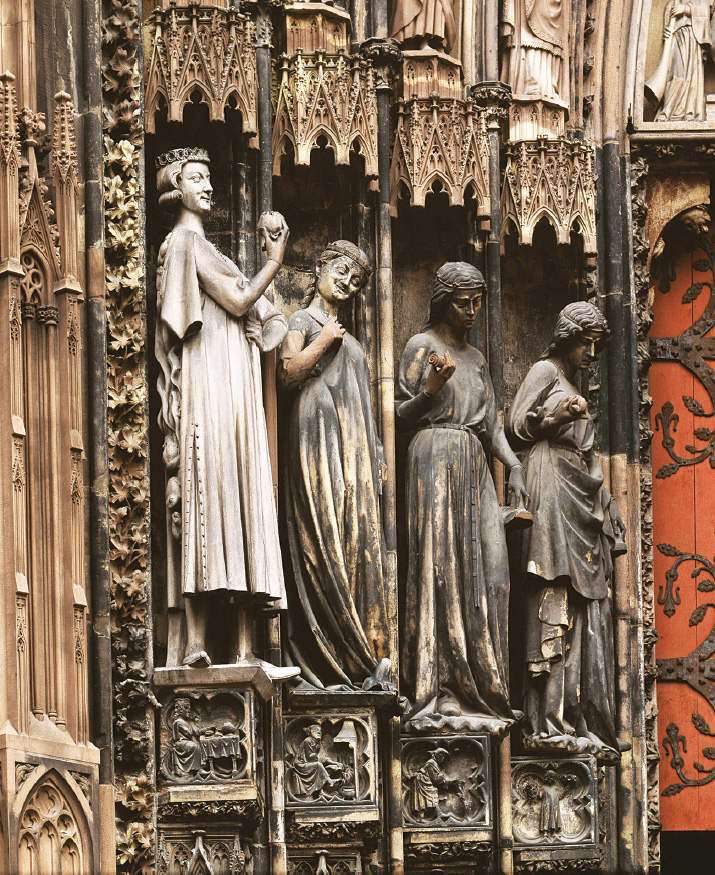A History of Western Society: Printed Page 295
A History of Western Society, Value Edition: Printed Page 302
Rituals of Marriage and Birth
Increasing suspicion and hostility marked relations between religious groups throughout the Middle Ages, but there were also important similarities in the ways Christians, Jews, and Muslims understood and experienced their religions. In all three traditions, every major life transition was marked by a ceremony that included religious elements.
Christian weddings might be held in the village church or at the church door, though among well-to-do families the ceremony took place in the house of the bride or bridegroom. A priest’s blessing was often sought, though it was not essential to the marriage. Muslim weddings were also finalized by a contract between the bride and groom and were often overseen by a wedding official. Jewish weddings were guided by statements in Talmudic law that weddings were complete when the bride had entered the chuppah, which medieval Jewish authorities interpreted to mean a room in the groom’s house.
In all three faiths, the wedding ceremony was followed by a wedding party that often included secular rituals. Some rituals symbolized the proper hierarchical relations between the spouses — such as placing the husband’s shoe on the bedstead over the couple, symbolizing his authority — or were meant to ensure the couple’s fertility — such as untying all the knots in the household, for it was believed that people possessing magical powers could tie knots to inhibit a man’s reproductive power. All this came together in what was often the final event of a wedding: the religious official blessed the couple in their marriage bed, often with family and friends standing around or banging on pans, yelling, or otherwise making as much noise as possible to make fun of the couple’s first sexual encounter. (Tying cans on the back of the car in which a couple leaves the wedding is a modern remnant of such rituals.)

The friends and family members had generally been part of the discussions, negotiations, and activities leading up to the marriage; marriage united two families and was far too important to leave up to two people alone. Among serfs the manorial lord’s permission was often required, with a special fee required to obtain it. (This permission did not, as often alleged, give the lord the right to deflower the bride. Though lords certainly forced sex on female serfs, there is no evidence in any legal sources that lords had the “right of first night,” the jus primae noctis.) The involvement of family and friends in choosing one’s spouse might lead to conflict, but more often the wishes of the couple and their parents, kin, and community were quite similar: all hoped for marriages that provided economic security, honorable standing, and a good number of healthy children. The best marriages offered companionship, emotional support, and even love, but these were understood to grow out of the marriage, not necessarily precede it. Breaking up a marriage meant breaking up the basic production and consumption unit, a very serious matter. The church forbade divorce, and even among non-Christians marital dissolution by any means other than the death of one spouse was rare.
Most brides hoped to be pregnant soon after the wedding. Christian women hoping for children said special prayers to the Virgin Mary or her mother, Anne. Some wore amulets of amber, bone, or mistletoe, thought to increase fertility. Others repeated charms and verses they had learned from other women, or, in desperate cases, went on pilgrimages to make special supplications. Muslim and Jewish women wore small cases with sacred verses or asked for blessings from religious leaders. Women continued these prayers and rituals throughout pregnancy and childbirth, often combining religious traditions with folk beliefs. Women in southern France, for example, offered prayers for easy childbirth and healthy children to Saint Guinefort, a greyhound who had been mistakenly killed by his owner after saving the owner’s child from a poisonous snake. The fact that Guinefort was a dog meant he could never become an official saint, but women saw him as a powerful and martyred protector of children.
Judaism, Christianity, and Islam all required women to remain separate from the community for a short time after childbirth and often had special ceremonies welcoming them back once this period was over. These rituals often included prayers, such as this one from the Christian ritual of thanksgiving and purification, called churching, which a woman celebrated six weeks after giving birth: “Almighty and everlasting God, who has freed this woman from the danger of bearing a child, consider her to be strengthened from every pollution of the flesh so that with a clean heart and pure mind she may deserve to enter into the bosom of our mother, the church, and make her devoted to Your service.”4
Religious ceremonies also welcomed children into the community. Among Christian families, infants were baptized soon after they were born to ensure that they could enter Heaven. Midwives who delivered children who looked especially weak and sickly often baptized them in an emergency service. In normal baptisms, the women who had assisted the mother in the birth often carried the baby to church, where godparents vowed their support. Godparents were often close friends or relatives, but parents might also choose prominent villagers or even the local lord in the hope that he might later look favorably on the child and provide for him or her in some way.
Within Judaism, a boy was circumcised by a religious official and given his name in a ceremony in his eighth day of life. This brit milah, or “covenant of circumcision,” was viewed as a reminder of the covenant between God and Abraham described in Hebrew Scripture. Muslims also circumcised boys in a special ritual, though the timing varied from a few days after birth to adolescence.